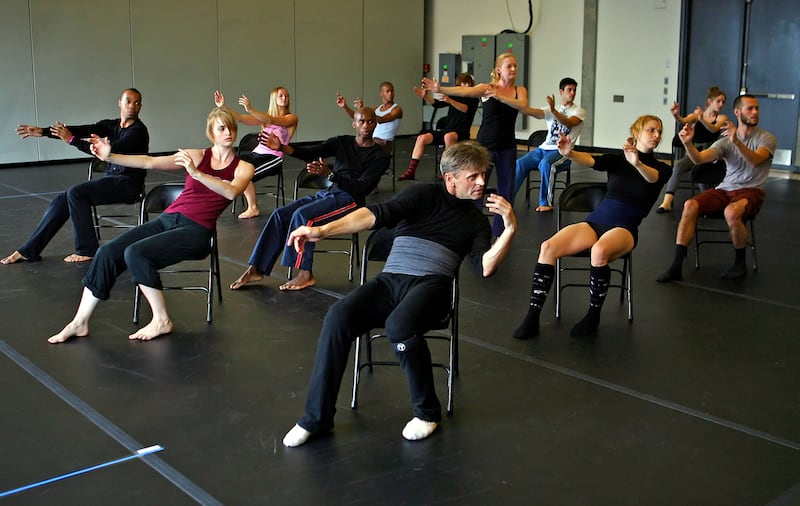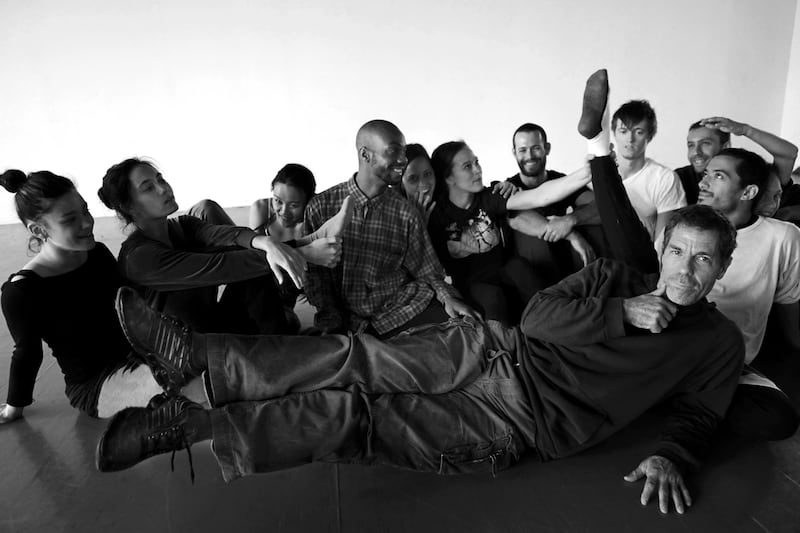Many choreographers work for years before gaining international recognition. Once their dances appear worldwide, they are deemed successful. Aszure Barton has been choreographing since childhood, but now that her work has been catapulted into theatres beyond her native Canada she is suddenly recognised as an artist who is reshaping audience and performers’ perceptions of dance.
Fittingly, her Happy Little Things (Waiting on a Gruff Cloud of Wanting) will open Bold Moves, Ballet Ireland’s upcoming triple bill of works that pushes beyond ballet’s norms. In addition, Ballet Ireland will revisit Minus 16, by the renowned Israeli choreographer Ohad Naharin, and present the premiere of All That Remains, by the Portuguese choreographer Filipe Portugal.
Barton grew up in Edmonton, in the province of Alberta, and trained in ballet. She quickly became more fascinated with crafting dances than with performing them, leading her away from a traditional ballet career and to New York for a period of time.
While exploring her choreographic voice she was introduced to Mikhail Baryshnikov, and he, already familiar with Barton’s reputation, asked to see her choreography. Impressed, he invited Barton to be one of the first artists-in-residence at Baryshnikov Arts Center in Manhattan. The two have since established a longtime collaboration, with Baryshnikov referring to Barton as one of the most innovative choreographers of her generation.

Those who know Barton talk about the honesty, physicality and musicality of her work, which fits the Bold Moves ethos of upending expectations while watching ballet. “I really like that Ballet Ireland is dancing Happy Little Things,” Barton says. “I was delighted when they asked for this work specifically.” In Happy Little Things, dancers eschew more traditional ballet vocabulary in favour of something collaborative, emotional and raw. “I am fascinated by dancers’ humanity, their human behaviour, and this work connects to two primary aspects of the human experience: individuality and community.”
Traditional ballet productions often feature soloists at the front of the stage against a backdrop of identically dressed corps de ballet moving in unison. Barton strips back this convention, preferring to uncover the way the individual contributes to the group instead of perpetuating dancers’ anonymity. Before creating something new, she taps into an honest and inclusive mindset and remains committed to a communal spirit throughout her process.
“I am deeply influenced by the dancers I work with, the dancers in the room at any given moment for any project,” Barton says. “Who they are becomes the fabric, the essence of the work. I find that the key to a successful process for me is creating an environment in which the artists are comfortable being themselves and doing anything, because I don’t ever tell them that what they’re doing is ‘wrong’. I do that by supporting their ideas and choices. I listen, observe and get supercurious and lost along the way, and that is typically my biggest motivator.”
What’s that like for dancers? “Like trudging through a swamp!” says Tobin Del Cuore, Barton’s assistant, who has staged Happy Little Things in Dublin. “I think a swamp is beautiful: the way the water meets the edge. However, when you go through it together first there is trudging and a lot to get through until you can walk, run and, eventually, take off and fly.”

Del Cuore first met Barton when he was with Hubbard Street Dance Chicago, a company known for presenting a wide-ranging repertoire. After performing Barton’s choreography first with Hubbard Street and then with her company, Aszure Barton & Artists, he began assisting her in staging and creating new dances.
“Any new work is always a bit of a shock physically, and it’s wonderful to see how the dancers of Ballet Ireland have done,” Del Cuore says. “Aszure’s work has a lot to do with isolation, in a very advanced way. It’s not only about body parts; it’s about rhythms, physical textures and ideas. It covers a wide range of emotional isolation, and there’s a lot of theatricality to her work. As a dancer you have to jump from the emotional to the theatrical and still somehow remain connected.”
Barton is not the first choreographer to launch from such an organic starting point with such astounding results. A fellow Canadian, Crystal Pite, is sometimes mentioned in the same breath, perhaps because they both pay attention to broader issues while bringing attention back to exquisite details in their choreography. Each of them also is skilled at using a huge number of dancers in awe-inspiring unison just as successfully as focusing in on a single dancer’s use of space.
Barton has gone down in dance history, however, as the first choreographer to create a dance where the performers were connected by their tongues – a far cry from her ballet beginnings, which she admits she found challenging.
“I rebelled a lot,” she says. “I didn’t agree with the hierarchies, and I didn’t understand the ‘why’ behind the tasks sometimes. Instead of following the rules, I wanted to create my own. I loved gathering friends together and making dances. I loved the adventure of it, the not knowing, the newness, the freedom. But I went to ballet school, nonetheless: it is still a part of who I am and my dance training, and therefore my dance making. I really admire the people that can do it and commit themselves to that world; it just wasn’t for me as a dancer. As a choreographer now, it’s about dismantling classical forms while simultaneously respecting them – a challenge I really enjoy.”
This tension between challenging and upholding tradition reverberates through ballet today, particularly because of the increased physical abilities of dancers, the greater understanding of the human body and the increased acceptance in the dance world of a more diverse range of body types.

Another choreographer featured in Bold Moves coined his own movement language 20 years ago, reflecting even back then the changing landscape of dance. Called Gaga, Ohad Naharin’s method is based on exploring new movement habits and finding new forms. Gaga is practised by dancers and nondancers around the world; a typical class involves participants being guided by a series of evocative instructions. These are designed to increase awareness and amplify sensations while connecting with the imagination and focusing on flexibility and stamina. Gaga emphasises enjoying movement in an accepting atmosphere. Participants often describe the experience as improvisational and deeply personal.
Naharin’s lifelong dedication to movement helped cultivate Gaga as a signature style for the Israel-based Batsheva Dance Company, which he directed for 20 years; the method infuses his dances such as Minus 16.

While Barton does not have a particular name for her own movement style, dancers describe it as process-oriented and much less focused on learning through watching and imitation.
“Something I often talk about is my long-held belief about how important it is to rethink and challenge our own ways of thinking and doing,” Barton says. “I look at choreography through a similar lens. I see the creation of physical language as an opportunity to recognise and let go of patterns and opinions that no longer serve us well in order to ground ourselves in change and unearth anew. My love of physical form, paired with a fascination with human behavior and universal connection, is the source of my dancemaking. I’m always searching for ways to reflect the complexities of the human experience through the body, because it is really the body’s inherent wisdom – opposed to the intellectual mind – that fascinates me most.”

This is the third iteration of Bold Moves, which is curated by Martin Lindinger, Ballet Ireland’s general manager. His 20-year career in ballet includes dancing with Rambert Dance Company, Hubbard Street Dance Chicago, Scottish Ballet, the National Ballet of Canada, and Ballet BC, also in Canada, as well as working as a teacher and repetiteur.
Programming Happy Little Things is a professional and personal triumph for Lindinger, as he and Barton both danced with the National Ballet of Canada at the beginning of their careers. Lindinger remembers his first experience with Barton’s choreography when he was dancing with Ballet BC in Vancouver and Aszure Barton & Artists came to town.
“They presented Busk and another dance of hers called Blue Soup. The first time I saw Busk the audience was screaming and hollering at the curtain call,” Lindinger says. “After that I was a big fan.”
Lindinger hopes to bring the same kind of infectious enthusiasm to this year’s Bold Moves. Anyone who has already witnessed Naharin’s Minus 16 will be familiar with the adrenaline rush in store.
“With a lot of contemporary dance the perception is that it’s quite serious and people don’t understand it,” Lindinger says. “Yeah, well, maybe you don’t have to understand it. There are a lot of works out there in the world that bridge that gap between great movement and entertainment. If it’s your first time going to the theatre, you will take something from this and, hopefully, be inspired.”
Ballet Ireland presents Bold Moves at the O’Reilly Theatre, Belvedere College, Dublin 1, from Friday, April 14th, until Saturday, April 22nd










